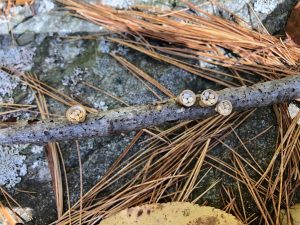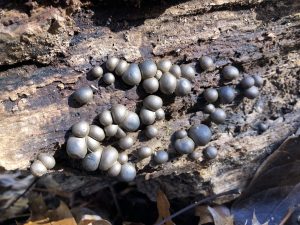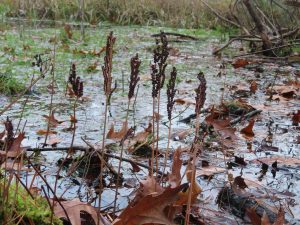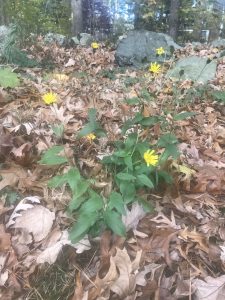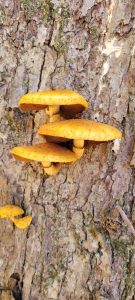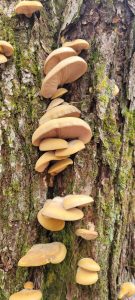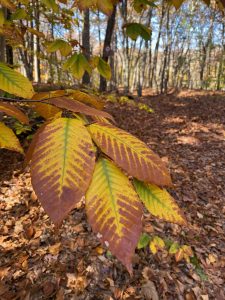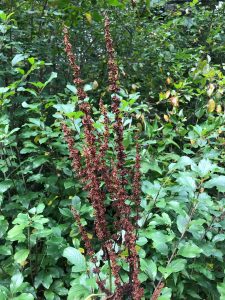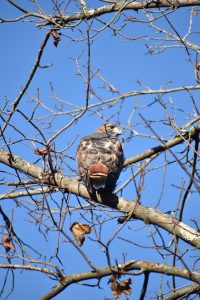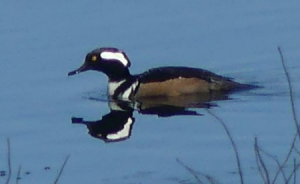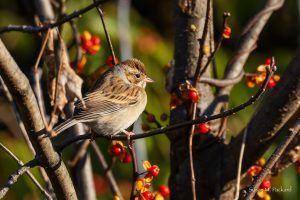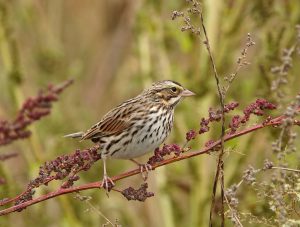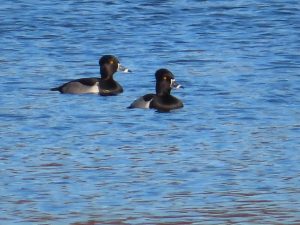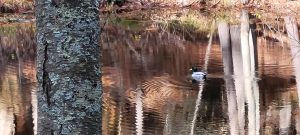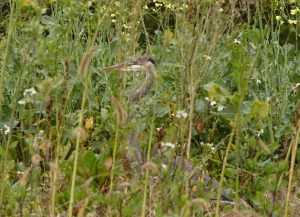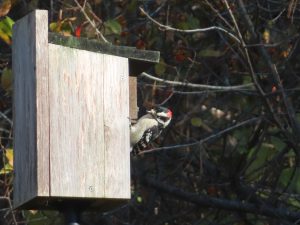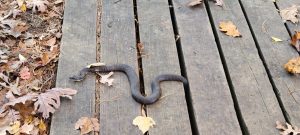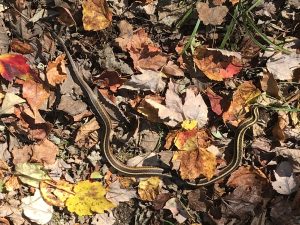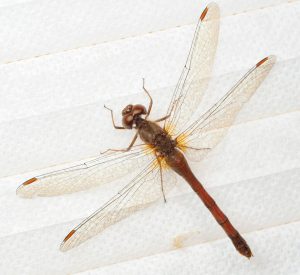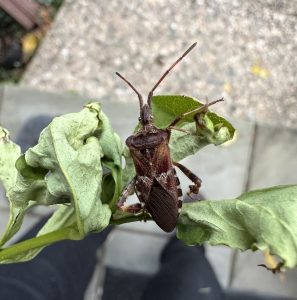Written by Gwyn Loud for the Lincoln Land Conservation Trust. She welcomes your sightings and questions at 781-259-8690 of gwynloud555@gmail.com
The past month has seen wide swings in temperature, with summery days (up to 80℉!) at the end of October and the first hard frost in early November. In my garden it came the night of November 1, but even a few feet in elevation can mean that the first frost occurs on different dates around town. During the unseasonably warm days some lilacs and forsythia even bloomed. Many deciduous trees still have leaves, giving a flickering display of green, gold and numerous shades of brown. After a generally muted season, some maples showed off their bright autumn finery right at the end of October. Along roadsides hawkweed is blooming, berries and seed heads abound, and on a woodland walk you may find various fungi. Winter weeds have their own beauty; look for the dark brown seed heads of dock and, in moist areas, the tall fronds of sensitive fern sporangia, holding bead-like spores. In response to recent programs about “Leave the Leaves” I hope more residents are saving fallen leaves to enrich the soil.
Fall birding brings rewards, especially as we see late migrants and flocks of birds such as red-winged blackbirds, American pipits, and many sparrows. Hawk migration is winding down but red-tailed hawks, Cooper’s hawks, and sharp-shinned hawks will remain with us year-round. Many American robins head farther south, but some will stay here all winter finding plenty of natural food. I have been watching them devouring the berries on my flowering crab trees. Ducks frequent ponds at this season. On Beaver Pond an observer spotted 125 ring-necked ducks, six black ducks, and a ruddy duck, and on Flint’s Pond bufflehead, common goldeneye, hooded mergansers, common mergansers, and ruddy ducks were spotted. On Farrar Pond nine mute swans can be seen, perhaps with more to come. Drumlin Farm has been very “birdy” recently with sightings off a brown thrasher, purple finches, Eastern meadowlarks (2), a Wilson’s snipe, pine and palm warblers, and several species of sparrows: clay-colored (2), field, white-crowned, Lincoln’s, swamp, and vesper. Elsewhere, chipping, song, and and Savannah sparrows were seen and white-throated sparrows are back here for the winter.
Other avian reports from around town include several great-blue herons, Virginia rails, a lingering black-throated blue warbler and yellow-rumped warbler, bald eagles by Farrar Pond, and pileated woodpeckers. An Old Sudbury Rd. resident spotted a pine siskin feeding on garden seeds; we may see more of these visitors from the north in the months ahead. As I said last month, those who feed the birds might want to participate in a citizen-science project called Project Feeder Watch, run by Cornell. I am doing it for the twentieth year and it has really sharpened my observations of what birds come to my feeders, their numbers, and behaviors. The requirements are easy and flexible. A few people have said their feeders do not seem very busy, but I think (and hope) that will change as cold weather sets in; at present birds can feast on a plentitude of wild food.
You may spot birds such as bluebirds checking out bird houses. Naturalist Mary Holland writes, “Although the breeding season for Eastern Bluebirds is long over, it is not unusual to see them return to nest boxes in the fall. Some are just briefly revisiting their former home, while others may linger long enough to exhibit some courtship behavior and even put grasses and nesting material in a nest box. The presence of bluebirds at bird boxes in autumn could mean that a successful male and female pair who have raised a family are staking an early claim on the box for next spring, or a male may be showing a potential new mate a good nest spot.” I have a downy woodpecker which disappears into a bluebird box at dusk, using it as a nighttime roost.
On Nov. 1 the American Ornithological Society, which determines the names of birds across the Americas, announced that it will be changing all bird names derived from people so as not to honor people with racist pasts. For example, the Audubon Shearwater (found off the coast of the southeast US) will get a new name, as John James Audubon, a famous bird artist, was also a slave owner and adamantly opposed to abolition. Scientific names (Latin) will not change. The changes will take a while to be determined and will affect 70-80 species in the US and Canada.
As for mammals, Carol Roede’s trail cam has shown plenty of nocturnal activity. She wrote, “A long-tailed weasel appeared several times, as well as an opossum, and a bobcat. The bucks are actively marking their territory. In front of one of my cameras, one buck has been scraping a sapling with its antlers, rub-urinating on the ground there, and chasing off another buck that came around smelling the area. A doe that came through later stopped to sniff the sapling that the buck had scraped. The raccoons are waddling around every night. On one video it looks like a raccoon is eating a worm – those invasive worms are everywhere here, and often just below the leaf litter, so not hard to find. And I did read online that raccoons eat them. If only they could eat them all.” Her camera also picked up a gray fox with its distinctive black tail tip. They are seen much less often than the common red fox. Other reports of bobcats came from Winter St., North Lincoln, and by Trapelo Rd.; they are definitely increasing in Lincoln. Chipmunks have not yet gone underground for the winter; they are very busy at my house gathering bird seed dropped from the feeders. On October 26 the police received several calls about a small black bear seen in the vicinity of 100-104 Lincoln Rd. Lincoln Road.
Northern water snakes and garter snakes have been observed recently, taking advantage of the spells of warm weather. A Weston Rd resident reported seeing newly-hatched baby snapping turtles (sadly, many squashed ones) as recently as November 5, and lots of leopard frogs in her backyard, which is quite moist. Overall, frogs are in serious decline world-wide so let’s treasure the ones we have.
As the temperatures drop, insects have different strategies for getting through the winter. Aquatic insects can survive as larvae or nymphs under the ice. Some insects seek warm dry microclimates in protected places such as under rocks and logs, in leaf litter or underground. Others go into a period of diapause, when they suspend development, much like hibernation, and pass the coldest months as eggs, larvae, or pupae. We also come across adult insects seeking winter shelter in our houses Example are field crickets and western conifer seed bugs, which are harmless but can be noisy as they fly, sounding like buzzing bees. Autumn meadowhawk dragonflies are very cold-tolerant and can still be found on mild days at this season. The spotted lanternfly, which damages many trees, has been reported as close as Wellesley and Weston.
The monarch butterflies which graced our gardens in the summer are now arriving in the mountains of central Mexico, where they will overwinter. As Mary Holland writes, “According to the World Wildlife Fund, Monarchs have suffered a sharp population decline and a loss of habitat in the forests where they winter each year. Last year the presence of Monarch butterflies in their wintering grounds dropped 22%, from 7 acres to nearly 5.5. acres. This is part of a mostly downward trend over the past 25 years —when monarchs once covered more than 45 acres of forest. While U.S. individuals can’t easily affect the challenges Monarchs face in Mexico, there is something we can do to counteract the diminishing supply of food for Monarchs migrating and breeding in the United States. Agricultural (and thus herbicidal) and urban expansion can be partially compensated for by the planting of milkweed, the one plant on which Monarch eggs are laid and which Monarch larvae eat.”
Looking to the dark skies, Nov. 17 will be the peak of the Leonid meteor showers, an annual event which occurs as the Earth moves through the gases left by the comet Tempel-Tuttle. The name Leonid drives from the point from which the meteors appear to radiant, in the constellation Leo.
Learn how to participate in Project Feeder Watch
Read more about changing the names of birds
Watch Carol Roede’s video of a gray fox
Read more about the spotted lanternfly
Learn what species of milkweed grow in your area


